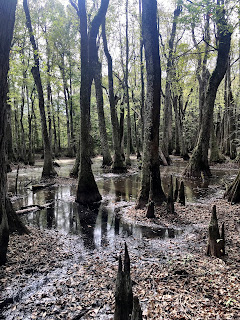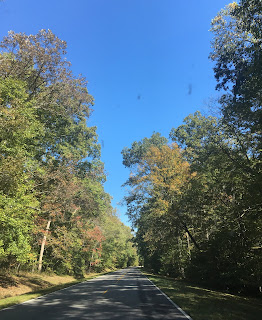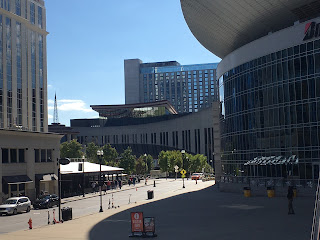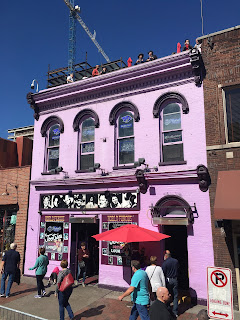As we left New Orleans and headed north over Lake Pontchartrain Causeway, the weather began to change and we had some heavy showers on our way to Natchez, MS.
Natchez, one of America’s oldest cities is situated on a bluff overlooking the majestic Mississippi River. It is full of easy elegance and casual charm, historic homes, lush gardens and moss-covered oaks. There are hundreds of antebellum houses here, from simple homes to very grand homes.
Our next stop was in Vicksburg, MS. The historic port sits on a high bluff on a bend in the Mississippi. The city, which was under siege for 47 days in 1863, played an important part in the Civil War. Abraham Lincoln said that Vicksburg was the “key” to the Union getting control of the Mississippi River. At the end of this siege, the Confederate Army under the leadership of General Robert E. Lee surrendered to the Union Army leader, General Ulysses S. Grant who went on to become the 18th President of the United States. We visited the Vicksburg National Military Park which preserves the main Civil War
We stayed in Bazsinsky House which was built around 1861.
It was in Vicksburg that on March 12th, 1894 that Coca-Cola was bottled for the first time.
It was in Vicksburg that on March 12th, 1894 that Coca-Cola was bottled for the first time.
We had dinner that evening in a 17th floor restaurant which offered good views of the surrounding area.
Natchez is at the start of the Natchez Trace Parkway which is a lovely 444-mile scenic drive
through three states and traverses a wide range of Southern landscape: thick, dark forests, soggy wetlands, gentle hill country and long swaths of farmland. It was a historic forest trail, created and used for centuries by many Native Americans, including the Natchez Indians. In 1801 President Thomas Jefferson designated the Trace a national post road for mail delivery between Nashville,TN and Natchez, MS. Today, the Trace Parkway creates a greenway from the bluffs of the lower Mississippi River to the southern Appalachian foothills of Tennessee.
Along the way we stopped and wet for a walk through a cypress swamp.
Along the way we stopped and wet for a walk through a cypress swamp.
Monday saw us in Kosciusko, a small town just off the Trace. It did not have very much to offer but Oprah Winfrey was born and spent her childhood there.
We overnighted in Tupelo, MS on Tuesday and visited Elvis Presley’s birthplace where he lived as a young child. The actual two-room family house where he lived is still there.
The land around the house is now a city park with statues and story walls, portraying Elvis’ life. He wanted a park for the neighbourhood children and donated the proceeds of a 1957 Tupelo concert to fund the building of this park.
The land around the house is now a city park with statues and story walls, portraying Elvis’ life. He wanted a park for the neighbourhood children and donated the proceeds of a 1957 Tupelo concert to fund the building of this park.
It was very wet on our drive to Tupelo but fortunately it cleared up when we reached Elvis’s home and we were even able to have a picnic lunch nearby.
On a cool Wednesday morning we continued our journey along the Trace. When we reached the stretch in Alabama we once again saw some cotton fields.
We did not see many Fall colours along the way, but nevertheless the journey was very pleasant and enjoyable.
We reached Nashville late in the afternoon after a drive of over 200 miles.
On Thursday morning we did a trolley bus tour of the city during which we saw the main sights of Music City.
The centre of Nashville is a street called Broadway which is full of Honky Tonk bars where live music is played most of the day and evening when it becomes loud, crowded and gaudy bright with neon signs.
That evening we went to an Opry Country Classics concert in the Ryman Auditorium (also known as the prestigious Mother Church) and famed for its acoustics and pew seating. Formerly the home of the Grand Ole Opry, the Ryman now shines on its own as a hallowed performance hall for all genres of musicians. The concert was good and the performers were excellent but as we are not C&W aficionados I don’t think we got as much enjoyment out of the show as the rest of the audience.
We then went for a bite to eat in one of the well known Honky Tonk music bars on Broadway called Tootsies.





























Great pics and info T. Permit me to state that General Lee surrendered to Grant at Appomatox Courthouse in April 1865 bringing the war to an end.
ReplyDeleteWhat a fantastic trip! Really enjoying photos of so many places I would love to see.The Civil War history adds a very interesting element to the campaign!
ReplyDelete